Dark matter versus neutron stars... round 1...
Neutron stars are amazing astrophysical objects on which we have currently a bunch of experimental data. On the other hand, dark matter is still directly elusive, although it is strongly favored by cosmological data.
These two can however have impact each other…
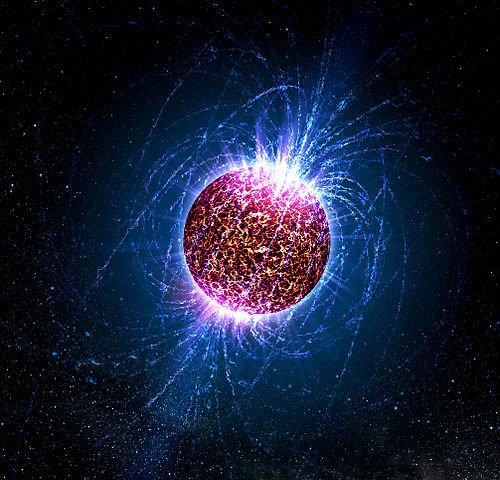
[image credits: wikimedia]
One potential dark matter scenario relies on baryonic dark matter. This consists in a class of dark matter particles that are baryons (this will be defined below), as can be guessed from the name.
This scenario recently attracted some interest due to intriguing discrepancies in recent measurements of the lifetime of the neutron.
But who says neutron, says also neutron stars. We have thus an immediate question to answer…
Could baryonic dark matter challenge the existence of neutron stars? This is what I will talk about today.
DARK MATTER
Dark matter is very standard today. The ensemble of all cosmological data indeed indirectly provides evidence that the major fraction of matter is of an unknown nature. Other theoretical explanations for the observations are possible, but they are in the end of the day no so strongly motivated as the dark matter setup.
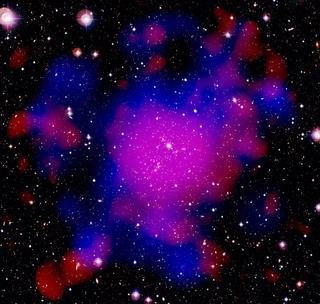
[image credits: ESA]
But what is dark matter exactly? This can be also guessed from the name…
The wording ‘dark matter’ comes from the fact that dark matter is ‘dark’, and that it behaves gravitationally, like normal ‘matter’.
And when I say ‘dark’, it actually contrasts with light, or in other words with electromagnetism. ‘Dark’ indeed means that dark matter consists of a form of matter that does not interact electromagnetically. This is simple :)
BARYONS
Let us now move on with the special class of dark matter particles I am interested in today: baryonic dark matter. In this expression, we can find the word ‘baryon’ which I will now discuss.
In particle physics, what we call baryons consist in particles made of three quarks. As I said it already in many other posts, quarks are the smallest observed constituents of matter. We can for instance find them in some German cheese.
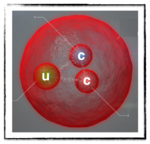
[image: CERN]
Quarks are sensitive to the strong interaction (one of the four fundamental forces of nature), which allows them to form composite states (see here and the picture on the left, for instance).
Amongst all the particles that can be made of quarks, some of them are in particular made of three quarks. These are called baryons.
The best known examples of baryons are definitely the protons and the neutrons that everybody knows, as all the atomic nuclei are made of protons and neutrons. It however actually exists an entire zoo of baryons.
THE SYMMETRIC INTERMEZZO
Physicists like symmetries. The more symmetric is our understanding of nature, the happier we are! Let us thus attach a symmetry to the baryons.
We hence enforce a baryon number symmetry. Each baryon hence possesses a baryon number equal to 1 and each antibaryon possesses a baryon number equal to -1.
And as for any symmetry. in any reaction, the total baryon number is conserved. Like for the electric charge.
For instance, a neutron can decay into a proton, an electron and a neutrino. The baryon number of the neutron is 1 and the baryon number of the proton is 1. Since neither the electron nor the neutrino are baryons, their baryon number is 0.
The considered neutron decay is thus allowed by baryon number conservation.
BARYONIC DARK MATTER AND THE NEUTRONS
Let us now put these two things together: baryons and dark matter. We obtain… surprize surprize… baryonic dark matter.
The idea is to assign a non-zero baryon number to the dark matter, which will drive its interactions with the visible world.
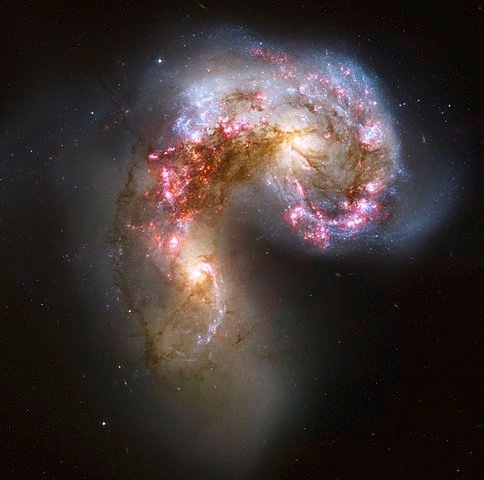
[image credits: Wikipedia]
Can we do that? Actually yes.
Data strongly constrains the way to do it, as baryonic dark matter will alter the baryonic world in a testable way. However, there is room to mess it up and motivated models consequently exist.
In particular, baryonic dark matter can mess up the properties of the neutrons if the dark matter mass is slightly below the neutron mass.
Is this a problem? Actually no: we need neutrons to be messed up!
There currently exist discrepancies in varied measurements of the lifetime of the neutron. The existence of light baryonic dark matter offers a new way to neutron to decays, so that we can restore agreement in data.
But who says neutrons, thinks about neutron stars. Baryonic dark matter can mess up neutron stars too!
MESSING UP NEUTRON STARS WITH DARK MATTER
Neutron stars are among the most compact objets in our universe. They arise from the death of a massive star, when the core of the latter collapses gravitationally. In this case, all protons and electrons that were present in the dead star structure are annihilated into neutrons.
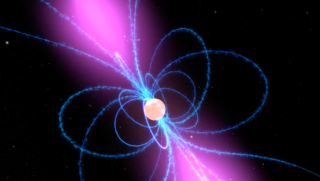
[image credits: NASA]
The connection with baryonic dark matter is immediate: baryonic dark matter messes up the properties of the neutrons, and thus with neutron stars.
Calculations have shown that baryonic dark matter with a mass close to the one of the proton and the neutron do not allow neutron stars that are heavier than the sun to exist.
This is however in conflict with the observations, so that neutron stars actually impose new constraints on baryonic dark matter scenarios. There are way out, but theories are becoming more complicated.
SUMMARY AND REFERENCES
In this post, I have discussed baryonic dark matter scenarios in which the dark matter mass is slightly smaller than the neutron mass. Whilst this setup could nicely explain discrepancies observed in the measurements of the neutron lifetime, it also challenges the existence of observed neutron stars.
As a consequence, baryonic dark matter scenario are still viable, but we must be careful and complicate the picture to have a theory consistent with data.
For more information, I recommend this research article that I have just read.
I may discuss the problematics of the neutron lifetime measurements in a future post.
SteemSTEM
SteemSTEM is a community-driven project that now runs on Steemit for more than a year. We seek to build a community of science lovers on Steemit and to promote well written/informative Science Technology Engineering and Mathematics (STEM) postings in order to make Steemit a place for fascinating STEM content.
More information can be found on the @steemstem blog and on our discord server and in our last project report.
Hello @lemouth ,
You talked about 'dark matters' and you concentrated more on' baryonic dark matter' and neutrons. I know there are other 'dark matter ' such as cold dark matter, hot dark matter and warm dark matter. Please can you enlighten me more?
There are plenty of forms of dark matter. Regarding the fact it is relativistic or not (its speed, in a few word), it is labeled at hot (ultra-relativistic dark matter), cold dark matter (slowly moving dark matter) or warm dark matter (in the middle). Note that hot dark matter is hardly viable as it does not account correctly for the formation of the small-scale structures in the universe.
Here, I only talked about a form of dark matter that carries a baryon number. It could be cold or warm, for instance, in concrete models.
Does it help?
Yeah. Good explanation. Thank you!
You are very welcome!
Thank you for posting this, I'm very intrigued by how dark matter fits into the big picture (like a lot of people I guess!). I have one question however, and that is why do we think there is any relationship between dark matter baryon's and neutron decay in the first place?
Dark matter actually fit very well. The chances it is there are extremely strong when you consider galaxy rotation curves, gravitational lensing data, cosmic microwave background analyses, etc... The only missing ingredient here is its direct detection. But it is not because we are not detecting it that it is not there. Our experiments have some sensitivity, and there are not built to cover all possible scenarios (hopefully they will in a couple of decades).
It is one option as valid as others. What is good is to be sure to consider everything and not leaver any loophole in our exploration.
I hope this clarifies!
LOL at the sexyscience tag. Just imagine a world where work like this truly was appreciated. Anyways, I was fascinated by your description of neutron stars and dark matter. A click bait title for someone like myself. Thank you for the great post and I look forward to more in the future.
The title is not really click-bait. It really means what I discuss in my post :)
Excellent post I have always been attracted to these topics of Physics @lemouth.
Regarding the following:
Particularly I think, that as science delves into the more exotic forms of matter, the theories will be even more complicated.
We like to start with minimality, when new theories are built. But sometimes, we need to give up minimality to be in agreement with data :)
I just stopped by to comment that I saw the movie Annihilation yesterday in the theater and the imagery and content of this post reminded me of it, haha.
is kind of theme in the movie...
Also sexyscience tag? better check that out a little more :P
I don't know at all about that movie. Just read the wikipedia page. It looks weird :D
Sexy science is sexy. Please ask @suesa :)
Hi, I found some acronyms/abbreviations in this post. This is how they expand:
Interestingly enough, this acronym is not really used here :D
Actually it is ;)
Ahaha... I missed it. Was too well hidden (and I actually forgot about it). Ok, one point for the bot :D
This is another side of physics a biologist will have to appreciate. Everything is all connected from the neutron to the cells, as a microbiologist I'm already relating these information to the microbial world. Very educative thanks
You are welcome!
I agree! Pr Henri Laborit approach that with his marvellous and "secret of secret"theory of "Les niveaux d'organisations".Hope it contribute positively to the discussion!
Hi @lemouth! You have received 0.1 SBD tip + 0.02 SBD @tipU from @cardboard :)
from @cardboard :)
@cardboard wrote lately about: Podgląd Naszego Konta Steem (Głosy, Komentarze) W Czasie Rzeczywistym: Steemblockexplorer + Auto Update Feel free to follow @cardboard if you like it :)
Excellent my friend @lemouth. Regards!.
You are welcome!